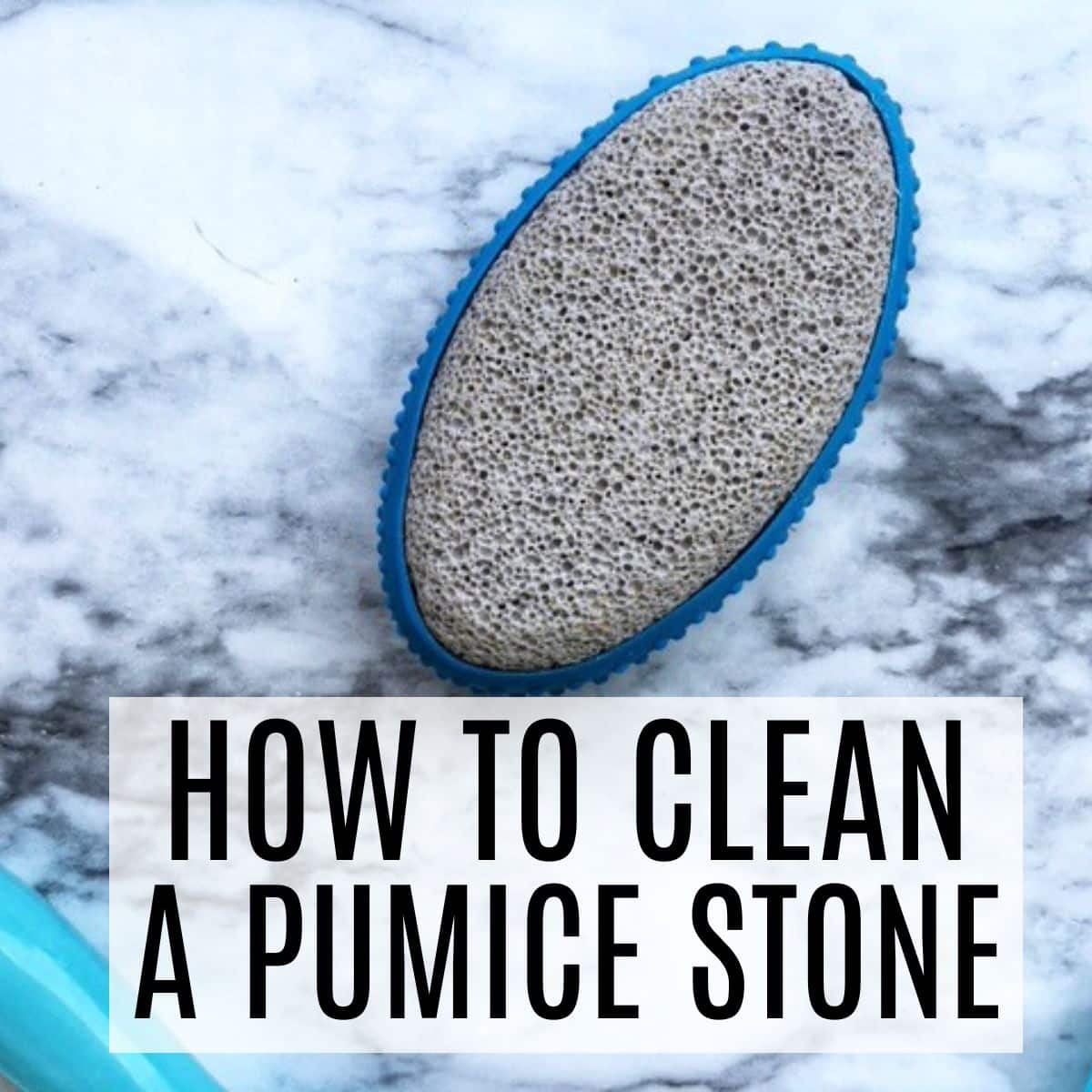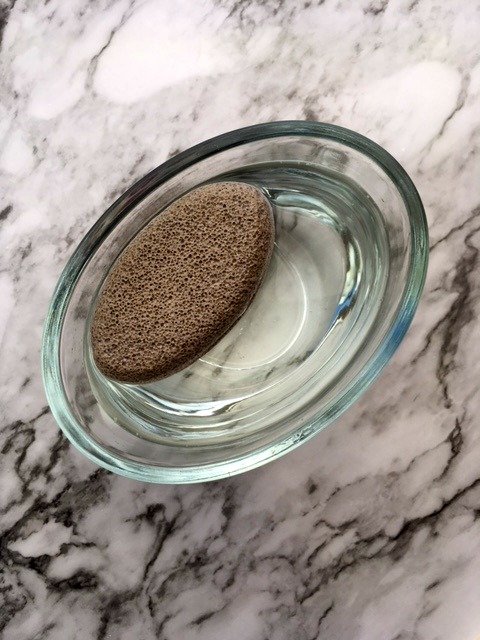Keep your pumice stone free from germs and bacteria with these simple tips. See how to clean a pumice stone quickly and easily and get rid of bad smells!

One of my most used bath products is my pumice stone. My niece got me a pedicure kit last year for Christmas and I love it! The pumice stone is one of the better quality ones I have had.
Plus I love that it has a gripper on the sides. I try to take pretty good care of it, not only so it will last a long time but also because pumice stones can be breeding grounds for bacteria.
Dead skin and germs manage to find their way into the stone and the humidity in the bathroom only makes things worse.
These stones need the occasional clean to stay free from germs and bacteria.
Use these 4 simple steps to remove the smell and bacteria from the stone, and getting it looking new again!
What You Need:
- Old Toothbrush.
- Water.
- Bleach. You can also use some leftover bleach to make a DIY Tide Pen for less than .25 cents!
How To Clean A Pumice Stone in 4 Easy Steps
Scrub Away the Dead Skin.
To start, you will want to clean away any dead skin in the pumice stone. Wet the pumice stone and then use an old toothbrush and dish soap to scrub away the dead skin. The toothbrush will help loosen the skin trapped in the holes and the dish soap will help with any body oils that are in the stone.
Make the Cleaning Solution.
Next, to clean a pumice stone you will need 2-3 cups of water and a tablespoon of bleach. Add the water and bleach to a bowl.
Soak the Stone.
Then, let the pumice stone soak in the bleach mixture for about 1-2 hours.
The bleach will help kill off any germs or bacteria so you aren't spreading them on your feet. The water will also help loosen any dead skin that is left stuck in the pumice stone. Plus, the bleach will help with any bad smells that are coming from the pumice stone.
The pumice stone has a tendency to float so you may need to turn it over after about 30 minutes to an hour.
Rinse and Dry.
After the pumice stone is done soaking then you can rinse it off and lay it out to dry. If you still have dead skin stuck in some of the holes give it a quick scrub again with the toothbrush. Quickly drying the stone helps prevent bacteria in the stone so I recommend laying it on a towel or cloth out in the sun so it dries faster.

Free Weekly Cleaning Printable
Clean your home in under 30 minutes a day with this free Weekly Cleaning printable!
Once the stone is dry it is clean and you can put it back where you normally store it. Regularly cleaning a pumice stone will help it last longer and keep it free from bacteria so I recommend washing it every couple of months. If you notice a lot of build up in your pumice stone it is probably time to clean it.
With these simple tips on how to clean a pumice stone, you can easily keep it clean and free from bacteria.

5 Ways to Use a Pumice Stone
Pumice stones are versatile tools that can be used in a variety ways, including:
- Removing calluses: Use the pumice stone to gently buff away the hardened skin on your feet, elbows, and knees.
- Smoothing rough skin: The stone can be used to smooth rough patches, such as those on the soles of your feet or the palms of your hands.
- Exfoliating: Pumice stones are great for exfoliating dead skin cells, leaving your skin feeling soft and smooth. This can also remove unwanted hair!
- Cleaning: Pumice stones can be used to clean grime and dirt from household surfaces, such as toilets, sinks, and stovetops. It will also shine up porcelain tubs like you have never seen!
- Cut through grease: You can use these in your oven or on grill grates to remove the hard deposits. Just be sure to keep it wet while cleaning.
When using a pumice stone, it's important to wet it first and use gentle pressure to avoid damaging your skin or surfaces. Also, be sure to clean and disinfect the stone after each use.
Do not reuse the stone on yourself if you intend to use it for cleaning purposes.
Common FAQs
Pumice stones have a porous surface, which means that they can potentially trap bacteria and other microorganisms within the crevices.
However, if a pumice stone is kept in a clean, dry environment and is only used on clean skin, the risk of bacteria growth is relatively low.
When a pumice stone is stored in a damp, dark environment or is used on skin that is not properly cleaned, it can become a breeding ground for bacteria.
This depends on how often you use it, the condition of the stone, and how well you maintain it.
Pumice stones can last for several months to a year or more with proper care. If they become overly worn or damaged, it may not work as effectively or could potentially cause injury to the skin.
If you notice significant cracks or deep grooves, or if it no longer seems to be removing dead skin effectively, it's probably time to replace it.
Additionally, if you have used the pumice stone on an area of skin with an infection or other condition, such as athlete's foot or a fungal nail infection, it's recommended to replace the stone immediately to avoid spreading the infection.
Yes, it's important to wash the stone after each use to remove any dead skin cells, dirt, oil, or other debris that may have accumulated on the surface of the stone during use.
This keeps it from growing bacteria and can extend the life of the stone. Be sure to let it air dry in the open.





Leave a Reply